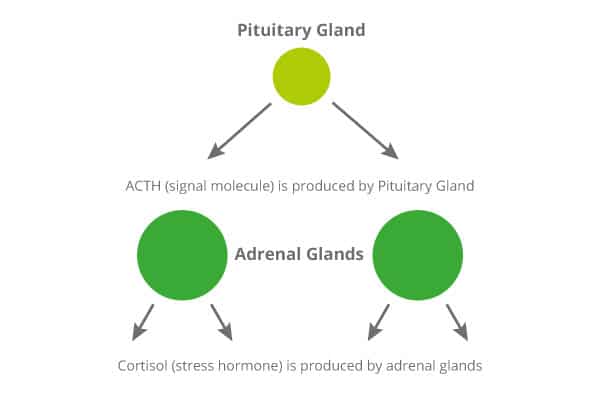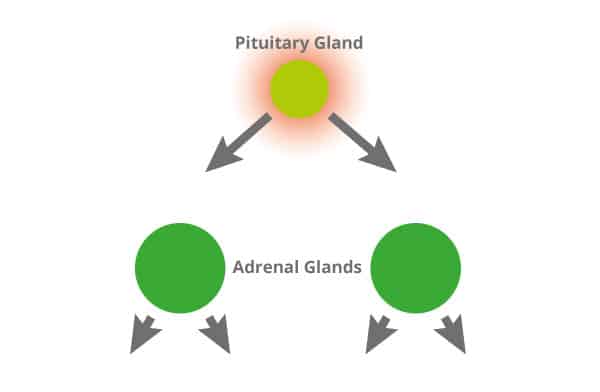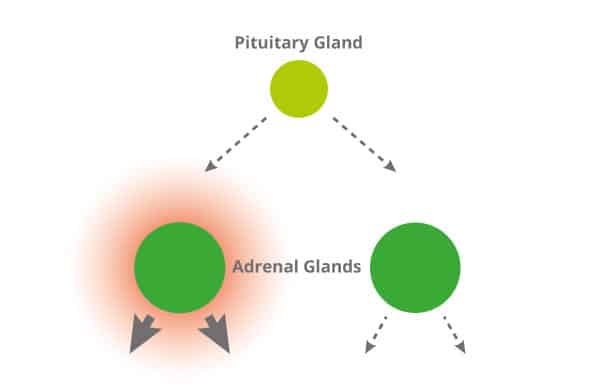
What is Cushing’s Syndrome (Hyperadrenocorticism)?
Cushing’s Syndrome, also known as hyperadrenocorticism, is a disease caused by excessive production of cortisol.
Cortisol is a very important hormone that the body needs on a day-to-day basis, but its levels need to stay within a normal range that the body normally regulates. Cortisol is produced by the adrenal glands, two small glands located near the kidneys in the tummy (abdomen). The adrenal glands are stimulated to produce cortisol by another hormone (called ACTH) which is released by the pituitary gland, a very small gland located in the lower part of the brain.

Why do dogs get Cushing’s Syndrome?
Cushing’s Syndrome occurs due to excessive amounts of cortisol in the bloodstream.
This can be caused by veterinary administration of high doses of steroids (such as prednisolone or dexamethasone), or more likely, a natural disease state, where there is either a small mass in the pituitary gland which produces too much ACTH, or a mass in the adrenal gland, which produces cortisol independent of any signal from the pituitary gland.
Pituitary Mediated Cushing’s Disease
Adrenal Mediated Cushing’s Disease
In dogs <20kg, 85% of Cushing’s Syndrome is caused by a pituitary tumour. In dogs >20kg there is a 50% chance that the problem is located in the pituitary gland, and a 50% chance it is in the adrenal gland.
Where the Cushing’s Syndrome is caused by a pituitary problem, in most instances the pituitary mass is small, but in rare occasions they can be large and cause additional problems due to their size. They are nearly always benign (do not spread). The size of pituitary masses can only be determined by a special brain scan (CT or MRI). If the tumour is large sometimes additional types of treatment can be performed to stop it growing.
When the Cushing’s Syndrome is caused by an adrenal mass, this mass could be either benign or malignant (50:50). It can be difficult to determine whether an adrenal tumour is benign or malignant and sometimes the only way is to remove the adrenal gland surgically.
What are the symptoms (signs) of Cushing’s Syndrome?
- increased thirst
- increased frequency and volume of urination
- increased appetite
- weight gain
- thin skin, and sparse hair coat
- ‘pot belly’
- muscle wastage
- calcification of the skin or ligaments
- excessive panting
- being prone to infections
- uncontrolled diabetes (see Diabetes Mellitus Information Sheet)
How is Cushing’s Syndrome diagnosed?
Cushing’s Syndrome can be very hard to diagnose. The disease can have similar symptoms to several other diseases such as diabetes, hypothyroidism and urinary tract infections. Cushing’s Syndrome is suspected after we have taken a full history and performed a detailed physical examination, but further tests are required to confirm the diagnosis.
Cortisol is normally present in the bloodstream, levels of cortisol increase whenever the body is ‘stressed’ (i.e. by illness, external strains or anxiety). A single blood cortisol test does not tell us if a pet has Cushing’s Syndrome, because numerous situations can lead to an increase in cortisol. We use the combination of urine tests, blood tests and ultrasound scans of the abdomen to diagnose Cushing’s Syndrome.
Routine blood screening in pets with Cushing’s Syndrome often show:
- Raised liver enzyme activities (these are chemicals produced by the liver)
- Increased cholesterol in the blood
Diagnosis of Cushing’s Syndrome requires hormonal testing. There are several types of hormonal blood tests which can be used, depending upon your pet’s particular situation. Sometimes it is necessary to perform a couple of types of hormonal tests to determine whether your pet does, or does not, have Cushing’s Syndrome.
How is Cushing’s Syndrome treated?
The excess of cortisol can be treated medically, with a medication called trilostane (VetorylTM) – Medical treatment of Cushing’s Syndrome.
The most common medication used in the UK to treat Cushing’s Syndrome is trilostane (Vetoryl®). This treatment is given once or twice a day as a capsule. The medication should be given with food.
When we first diagnose Cushing’s and dispense medication we start off on a reasonably low dose and perform regular checks to assess the control. The reason for this cautious approach is that over-suppression of the adrenal glands, causing low cortisol, can cause serious problems- manifesting as sickness, lethargy, diarrhoea or collapse. Determining the correct dose of trilostane involves discussion of their symptoms, and blood tests – often an ACTH stimulation test (blood test, injection, then 1hr later another blood test). This test is usually performed 3-6hrs after the Vetoryl is given in the morning. Sometimes it is necessary to increase the dose depending on the results of further blood tests and your pet’s response to treatment.
What is the long term outlook for Cushing’s Syndrome?
In most instances, Cushing’s Syndrome disease can be well managed, and your dog will enjoy an excellent quality of life. Where particular challenges exist – such as an adrenal mass, or a large pituitary mass, in many situations, additional treatment options exist, to help us to secure the best future outlook for your dog; your specialist will discuss all these things at your appointment.
If you have any queries or concerns regarding your pet and Cushing’s Syndrome, please do not hesitate to contact us.
Arranging a referral for your pet
If you would like to refer your pet to see one of our Specialists please visit our Arranging a Referral page.

